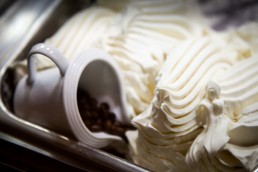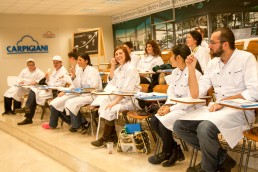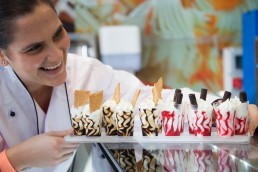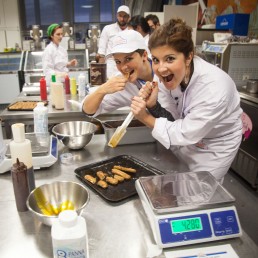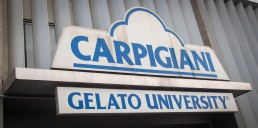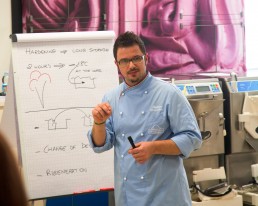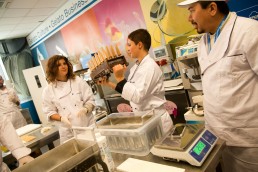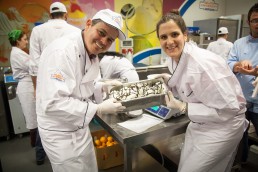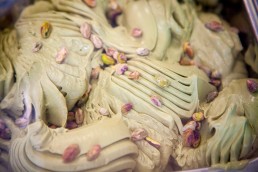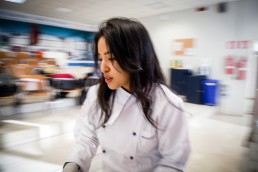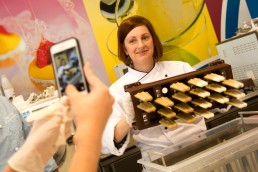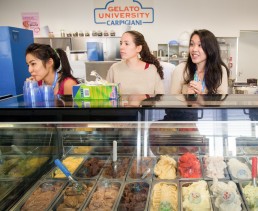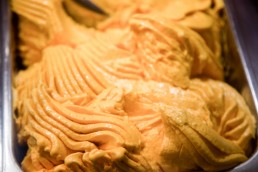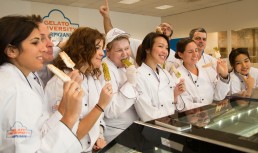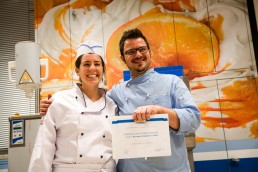To make Italy's favourite treat like an old-school artisan, culinary entrepreneurs head to beautiful Bologna and the Carpigiani Gelato University.
HOME TO EUROPE’S FIRST university and a magnet for nicknames, the enchanting city of Bologna is affectionately referred to in Italy as la dotta, or “the learned one”. It has also been dubbed la grassa — “the fat one” — in recognition of the local appetite for eating well. Bologna, then, is the ideal place to get an education in Italy’s favourite feel-good treat.
The University of Bologna was established in 1088. Almost 1,000 years later, in 2003, the Carpigiani Gelato University flung open its doors to become the world’s foremost school for learning how to make quality gelato like an old-school Italian artisan. I’ve signed up for the first module in its month-long ‘Become a Gelatiere’ training programme.
Over five days I will sample more frozen dessert than in the previous five years, swooning over vanilla, hazelnut, coffee, chocolate, almond, milk stracciatella (think chocolate chip, but better), pistachio and even tiramisu gelato, and melting for sorbets of orange, strawberry, banana, pineapple, raspberry and kibana (that’s kiwi and banana).
In a dozen or so cases, under the tutelage of a bona fide Italian gelato master, I’ll rustle up the stuff myself. Sweet!
Promo for Carpigiani's basic gelato course. Video: Carpigiani Gelato University/YouTube
CARPIGIANI GELATO UNIVERSITY is located on an industrial estate just outside Bologna, which is the capital of the affluent northern Italian region of Emilia-Romagna. Students quickly lose any romantic ideas they might have gleaned from glossy gastronomy magazines. Nobody at the Gelato University rolls out recipes on the dreamy, sun-kissed verandas of lovingly restored farmhouses, all the while sipping on a fruity Barolo and nibbling on bruschetta.
This is not a cookery course held amongst the fragrant olive groves of rural Tuscany. In stark contrast, the intensive Carpigiani curriculum is taught in a classroom and a laboratory, and the students are would-be gelato entrepreneurs from across the globe. My class of 14 includes citizens of Australia, Brazil, Egypt, Honduras, Indonesia, Israel, Malaysia, Saudi Arabia, Slovakia, the UK and the US, thereby covering every continent except Antarctica.
The age range spans more than three decades with the youngest being 25-year-old Indonesian Tiffany and the most mature being Othman, 58. Backgrounds are also varied — while Othman is a veteran Saudi Arabian Airlines pilot who took voluntary redundancy in 2012, Los Angeles-based TJ is a former nurse and an occasional stand-up comedian.
ALL THE STUDENTS have a common goal, however: to start their own gelato businesses. Should their dreams come true, coming years will see gelaterias popping up in Tel Aviv and Sao Paulo, from Singapore and Melbourne to Cairo and Berlin. Tiffany aims to open in Bali, while Othman plans three shops in Jeddah.
Our teacher is gelato master Stefano Tarquinio, and day by day he gradually divulges the secrets of perfect gelato taste and structure. He instructs us in how to balance sugars, on pasteurisation and thermal-shock techniques, and explains why air content affects flavour intensity. The chemistry and mathematics involved are a surprise and a calculator proves essential.
But the first thing we learn about gelato is never, ever to call it ice cream. When created by artisanal methods, effervescent Tarquinio insists, gelato is “healthy emotional food” with a significantly lower fat content than the mass-produced confection.
THE DAYS OF STUDY are long but most evenings classmates get together to explore Bologna, meeting at its moody and magnificent 15th-century Piazza Maggiore, then wandering the centro storico — old city — in search of a bustling pizzeria or a traditional osteria for an evening aperitivo (the preferred Bologna tipple being a gaudy-orange Aperol spritz) and a feed.
As well as la dotta and la grassa, Bologna is also called la rossa — “the red one” — and the centro storico’s architecture has an unrelenting palette of terracotta and cinnamon, of dusty pinks and burnt oranges, with many buildings dating back to the Renaissance or earlier. (La rossa also refers Bologna’s left-wing political leanings — perhaps odd considering that it is one of the wealthiest cities in Italy.)
According to the university’s director, Kaori Ito, a hunger for quality gelato is growing internationally and it now caters to about 7,000 students a year
It never takes long to seek out a suitable eatery — Bologna is one of the best cities in all Italy for dining out and renowned for egg-based pastas such as tagliatelle, tortellini, pappardelle and cappelletti, as well as excellent mortadella and prosciutto, and Parmigiano-Reggiano cheese. It’s also the home of Bolognese sauce, although surprisingly the local ragu is generally made without tomatoes and always paired with tagliatelle — never spaghetti.
Evenings invariably conclude with a stroll through Bologna’s famous porticos in search of — of course — gelato. The city boasts about 40 kilometres of the covered walkways that provide shelter from blazing sunshine in summer and snow in winter. Top-quality gelaterias are easy to find — Bologna has more than 300, or at least one for every 1,000 or so residents.
ACCORDING TO THE UNIVERSITY’S director, Kaori Ito, a hunger for quality gelato is growing internationally and it now caters to about 7,000 students a year. Though my lessons are conducted in English, courses are also held in Italian, French, Spanish, German and other languages. In January, classes were taught in Bologna for the first time in Mandarin Chinese, attracting new students from Taipei, Shanghai and Beijing.
What’s more, Ito says, gelato — in Italy at least — has proven recession-proof, with the economic crisis of recent years actually resulting in more students signing up than ever before.
“People started looking at their lives, their jobs, and started looking for a change,” she says, adding that more than a few students are free spirits that want out of the rat race. “Many have just decided to follow their dreams.” ◉
An edit of this travel story ran in Post Magazine in 2014. Download PDF. I wrote further gelato-business articles for Traveller and Good Food in Australia, the South China Morning Post in Hong Kong, Toronto Star in Canada and Sands Style, which was the magazine of the Las Vegas Sands casino group in the United States.
SHARE


